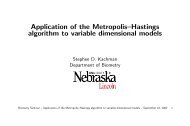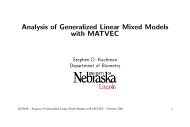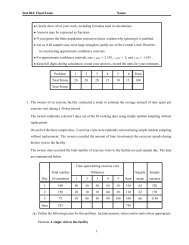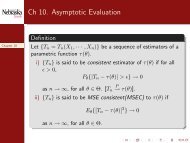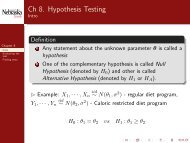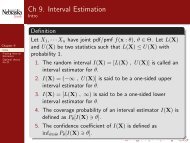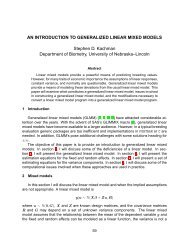Matvec Users’ Guide
Matvec Users' Guide
Matvec Users' Guide
- No tags were found...
You also want an ePaper? Increase the reach of your titles
YUMPU automatically turns print PDFs into web optimized ePapers that Google loves.
Chapter 12<br />
Segregation and Linkage Analyses<br />
12.1 Genotype Probability Computation<br />
It is very difficult, in general, to compute the genotype probabilities for each member of a pedigree with<br />
loops . Van Arendonk et al. (1889), Janss et al. (1992), Fernando et al. (1993), and Wang et al. (1995)<br />
discussed and proposed an iterative algorithm to compute the genotype probabilities for large and complex<br />
livestock pedigrees. The proposed iterative algorithms are based on primary works by Murphy and Mutalik<br />
(1969), Elston and Stewart (1971), and Heuch and Li (1972).<br />
The conditional probability that pedigree member i has genotype u i given all the phenotypes y 1 , . . . , y n<br />
can be computed as<br />
Pr(u i | y 1 , . . . , y n ) = a i(u i )g(y i | u i ) ∏ jɛS i<br />
{p ij (u i )}<br />
∑<br />
u i<br />
a i (u i )g(y i | u i ) ∏ (12.1)<br />
jɛS i<br />
{p ij (u i )}<br />
where a i (u i ) is the joint probability of phenotypes of members anterior to i and of genotype u i for i,<br />
g(y i | u i ) is the penetrance function, and Π jɛSi {p ij (u i )} is the conditional probability of phenotypes of<br />
members posterior to i, given i has genotype u i .<br />
The anterior probability, a i (u i ), and posterior probability, p ij (u i ), can be computed as<br />
a i (u i ) = ∑ u m<br />
{a m (u m )g(y m | u m )<br />
× ∑ u f<br />
{a f (u f )g(y f | u f )<br />
∏<br />
jɛS m,j≠f<br />
∏<br />
jɛS f ,j≠m<br />
p mj (u m )<br />
p fj (u f ) (12.2)<br />
×tr(u i | u m , u f )<br />
⎡<br />
⎤<br />
× ∏ ⎣ ∑ tr(u j | u m , u f )g(y j | u j ) ∏ p jk (u j ) ⎦}}<br />
u j kɛS j<br />
jɛC mf ,j≠i<br />
and<br />
p ij (u i ) = ∑ ∏<br />
{a j (u j )g(y j | u j ) p jk (u j ) (12.3)<br />
u j<br />
× ∏<br />
kɛS j,k≠i<br />
kɛC ij<br />
[ ∑<br />
u k<br />
tr(u k | u i , u j )g(y k | u k ) ∏ lɛS k<br />
p kl (u k )<br />
]<br />
}<br />
where C ij (C mf ) is the set of offspring of parents i and j (m and f).<br />
The step-by-step iterative algorithm is given below:<br />
1. For each member i:<br />
87




